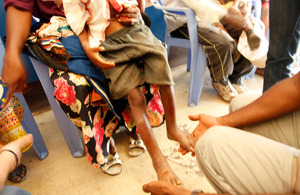DFID Research: The Hunger and Nutrition Commitment Index
A new index reveals that political will has a vital role to play in tackling hunger and undernutrition.

A boy is checked for signs of malnutrition in the local hospital, Masi Manimba, DRC. Picture: Russell Watkins/Department for International Development
Earlier this month the Hunger and Nutrition Commitment Index (HANCI) was launched. Partly funded by Transform Nutrition, HANCI looks at 45 countries and measures their political commitment to tackling hunger and malnutrition by evaluating 22 policy, legal and spending indicators.
Currently 870 million people in the world do not have enough to eat. While this number has fallen by 130 million since 1990, progress has slowed in recent years. Similarly, progress in reducing the numbers suffering from undernutrition has been fairly static in the past 5 years; it still contributes to the deaths of 2.6 million children under 5 each year.
Produced by the Institute for Development Studies, this index is the first of its kind. The Global Hunger Index in 2012 demonstrated that progress in reducing hunger has been worryingly slow, the HANCI aims to measure how levels of political commitment play a part in this. It highlights the lack of progress towards meeting the targets set out in Millennium Development Goal 1, referring to the high levels of stunting in South Asia and Sub-Saharan Africa which remain at 40%.
Identifying that in many developing countries there has been significant economic growth over the last few years, the HANCI looks at why this does not necessarily impact on levels of undernutrition and hunger. A driving factor is seen to be lack of political will.
The report looks at 3 areas of government action:
- Policies and programmes
- Legal frameworks
- Public expenditures
Commitment to reduce hunger and commitment to reduce undernutrition are clearly delineated as separate issues. The report highlights that hunger can be identified as a key driver in migration, conflict and gender discrimination. Undernutrition, however has different causes and consequences. It is not always related to hunger and can be caused by impaired facilities for nutrient uptake due to disease. In a vicious cycle, this lack of key nutrients results in increased susceptibility to disease and impairs the immune system and physical and mental development.
By separating the 2 issues the index is able to highlight interesting disparities. For example, as Dolf te Lintelo, an author of the report points out, Nepal is rated third in the index for political drive to reduce undernutrition, however it is ranked 34th in its commitment to reduce hunger.
Thus the HANCI provides a more comprehensive insight into the specific political interventions needed. For example, it highlights that while government support for child care and improved sanitation may improve nutrition but have little effect on hunger, similarly subsidized food in shops and emergency food aid target hunger but don’t contribute to a balanced diet.
HANCI has developed 2 tools designed to enhance the accessibility of the data used in the index.
- Global View: this is an interactive map allowing users to compare HANCI rankings
- Weigh your priorities for action: this tool allows users the opportunity to explore how rankings change according to different prioritization of the three areas of government action- Policies and programmes, Legal frameworks or Public expenditures
The HANCI website also provides access to individual and collective accounts, gathered during data collection, from communities affected by undernutrition in Malawi, Bangladesh and Zambia.